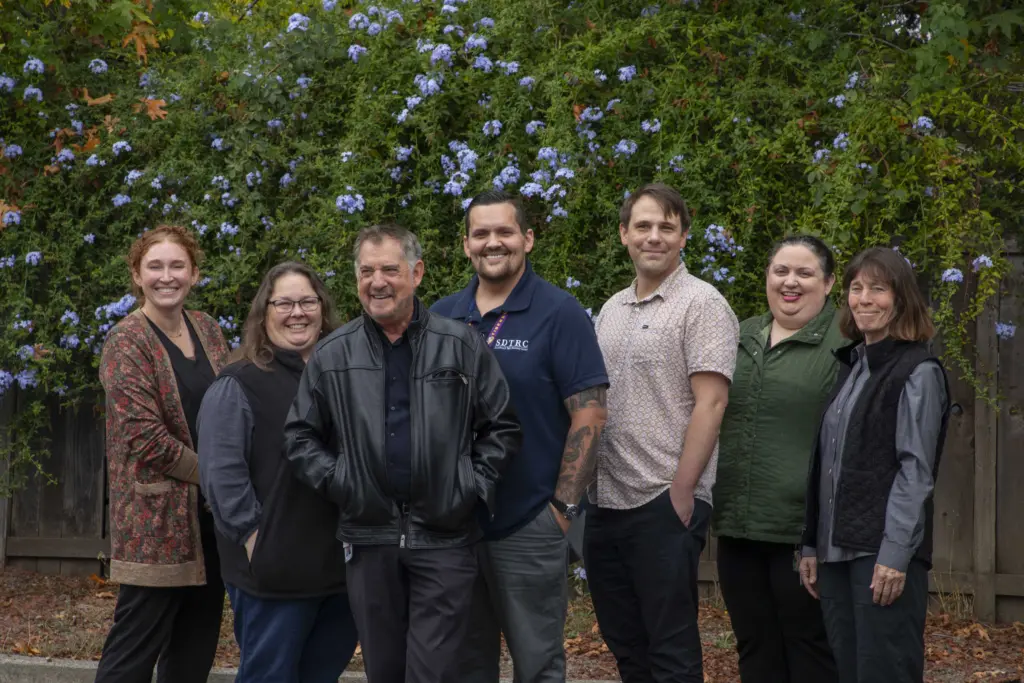
An estimated 7,137 people died from a fentanyl overdose in California in 2023, according to the California Department of Public Health.
It’s challenging enough getting a person afflicted by addiction into recovery just once. Kai Denis, of Santa Rosa treatment nonprofit Center Point DAAC, will never forget the man who came back again and again.
And again.
The man was on parole and enrolled in the recovery center’s intensive outpatient program, recalls Denis, DAAC’s (Drug Abuse Alternatives Center) current director of medication assisted treatment, who was the man’s counselor at the time. Disillusioned by a lack of employment, money and prospects, he would place Denis on the receiving end of his loud frustrations—angrily vowing to give up his recovery efforts and be sent back to prison, which would be “easier than doing all this.”
Despite his initial dedication to the program, within a few months the man suffered a relapse. But he pulled himself together, re-enrolled in the program and graduated. Six months later, he suffered another relapse. But, again, he re-enrolled in treatment—this time in DAAC’s residential program. By this time, the man was so familiar with the program, “he could almost run the place himself,” says Denis. The staff was invested in his success and held him to a high standard, while newer DAAC clients looked to him as a role model.
After nearly three years of struggle to overcome the grip of addiction, this time his recovery stuck.
“It was significant,” Denis says of that success story. Because not all people who need treatment are as determined to make treatment work. “He was aware that [DAAC’s] resources were out there [for his own benefit]—he knew he had no excuse not to use it.”
Today, the man has a “pretty decent paying” job in the transportation industry, says Denis. Unfortunately, not every user is as committed to climbing their way out of addiction—and delivering the message about what recovery centers such as Center Point DAAC have to offer is a critical priority for the nonprofit.
‘We’re not reaching the people we should’
“We’re trying to address a statewide problem,” says Chris Geiger, of Center Point DAAC. “We’re not reaching the people we should—and not getting them into treatment fast enough.”
Geiger is the interim regional vice president at Center Point DAAC (Drug Abuse Alternatives Center and Center Point, Inc. merged in 2012) which, along with a host of diversion and outpatient services, runs the residential Dr. Sushma D. Taylor Recovery Center. The $7.6 million facility celebrates its year anniversary in operation in Santa Rosa this fall.
DAAC was founded in Santa Rosa in 1969, when drug abuse was growing in the area and effective treatment and recovery services were rare. It was a time and place very familiar to Geiger, who grew up in Sonoma Valley and battled drug problems of his own as a teen.
“Around that whole period free love and drugs and rock ‘n’ roll was happening and I dove headlong into it,” recalls Geiger. His father, an orthopedic surgeon, had befriended “gonzo” journalist Hunter S. Thompson, who at the time was living with his young family in Glen Ellen. In fact, says Geiger, “the first time I ever got high with anybody” was with the Fear and Loathing in Las Vegas author (who had dedicated the book to Geiger’s father, Robert). “That whole scene was pro drug, so I was kind of set up in a way to be a drug addict,” Geiger says.
By the time he was 18, Geiger was addicted to heroin and committing various forms of theft to support his habit. Encounters with law enforcement led to treatment in the Walden House program in San Francisco which, once clean, hired Geiger to help with special projects—taking the former addict on an eventual career path toward social justice and working in recovery. “[Addiction] led to a really interesting career,” says Geiger.
Geiger has experienced substance abuse and treatment from all sides—as an addict, as a person rehabilitating and as a leader for recovery programs—and it’s given him perspective on the necessary facets for effective treatment. And he believes Center Point DAAC has honed its operations into a model that works.
High-quality, low cost
“Nowhere else in Northern California are you going to find a MAT [medication assisted treatment] detox with this level of care that takes people on Medi-Cal,” Geiger says about Center Point DAAC and the medically managed withdrawal process at the heart of many of its treatment regimes. In other words, Geiger believes addiction treatment can and should hold up to that shopworn business maxim: Great service, at an affordable price.

Geiger cites DAAC’s withdrawal-management programs as being “as good as any in the state,” supported by 24-hour nursing staff, an addiction-certified medical director and deputy medical director. He says DAAC approaches treatment from a holistic standpoint, with a menu of services including evaluation for anxiety and depression, blood/lab work and assessment of physical health. If there’s a level of care needed that DAAC doesn’t offer, they’ll refer patients to the necessary medical provider. “It makes us unique in anything else you’re going to find in Northern California,” he says.
David Panush is president of California Health Policy Strategies, a Sacramento-based consulting firm shaping policies to improve the state health-care system. He’s worked with Center Point DAAC on honing its treatment approach and views it as “part of what the system could be.”
He juxtaposes the way traditional recovery treatment works versus other serious health conditions. “If you went to an emergency room for a heart attack, you’d expect to have follow-up care,” says Panush. “[The medical team] would find out what’s going on, have a treatment regime for you, and they would track that.” But if someone goes to an emergency department with an overdose, he points out, there’s rarely adequate managed care after they’re discharged.
“If two-thirds of people coming into an emergency department with an overdose are not getting follow up, that needs addressing,” says Panush. “No other disease sees this kind of lack of follow-up care.”
Adds Panush: “[Center Point DAAC] is not only addressing this from a communication standpoint but is actually bringing people together—they’re developing the relationships so you can have follow-up care, or [preventative] so people don’t wind up in the emergency room to begin with.”
One of those relationships is with Sonoma County Behavioral Health Services, which oversees contracts for the various programs partnered with the county—and Center Point DAAC is among its largest contractors. When users seek admittance to DAAC’s residential program, the state requires county authorization within 24 hours, a tight window subject to bureaucratic delays.
Will Gayowski, program manager at Sonoma County Behavioral Health Services, says they’ve worked with DAAC to streamline the admittance process and recent averages have been under 24 hours. Gayowski describes the county’s work with DAAC as “long and fruitful,” and that “in terms of value of service and quality it’s probably the best it’s been in years.” Gayowski credits DAAC’s growth to its ability to attract “higher quality employees.”
“DAAC has a really strong partnership with our federally qualified health centers, so they get good MDs,” says Gayowski. “They’ve built up their medical model and are having a more medically directed and supported withdrawal experience that’s safer and more effective.”
The Medi-Cal question
Client safety is the “lens” through which DAAC views its mission, says Geiger. “The decisions we make need to be client oriented—for the client’s safety.” But that lens could become foggier in 2026 when changes to federal spending on health care go into effect.
More than $1 trillion in cuts to Medicaid spending are expected over the next 10 years, according to data from the Congressional Budget Office’s analysis of the recent legislation known as the One Big Beautiful Bill Act. Those cuts will trickle down to such state programs as Medi-Cal, potentially making it challenging for Center Point DAAC to sustain the high level of care that makes its programs successful. “We’ll need to have a plan to address that,” says Geiger.
Meanwhile, at the top of DAAC’s priorities is public outreach—to let people know their services are available, far and wide. “The more information we can bring, the better,” says Denis. There’s misinformation about “the fear of withdrawal—how bad it’s going to be—which could be enough to scare people away from taking the first step.” But medication-assisted treatment mitigates all that, he says, and “there are a lot of people who are simply not aware.”
Establishing a network
Beyond Sonoma County, DAAC has an agreement with Partnership Health Plan of California—a nonprofit which networks with local providers such as DAAC to administer Medi-Cal benefits—to take client referrals from seven Northern California counties. It’s part of DAAC’s vision to address addiction from a statewide perspective; the nonprofit is working under the theory that many of the bureaucratic problems in recovery stem from local agencies working in silos, not as part of a broader network with the same goals.
“We want our marketing efforts to reach people so they can raise their hand and say, ‘I’m ready for help,’” says Geiger. DAAC’s goal, he says, is to raise its baseline number of clients, while tracking and improving the timeframe for getting them into treatment. Once DAAC establishes its data of improved treatment outcomes, they can convert that model to counties similarly situated to Sonoma—such as Fresno, another medium-sized county surrounded by rural counties.
Geiger’s plan involves working through Partnership Health Plan’s network of agencies to replicate the changes being implemented at DAAC. Through greater collaboration between agencies that interface with clients, Geiger hopes to establish stronger referral relationships making it easier to identify the barriers keeping addicts from treatment and develop plans to remove them.
‘The stakes are higher’
Meanwhile, the synthetic opioid crisis continues to claim lives. An estimated 7,137 people died from a fentanyl overdose in California in 2023, according to the California Department of Public Health. While the 2024 fentanyl-related deaths were down to just under 5,000 statewide, health experts are cautious to assume the tide has turned on the opioid epidemic, says Dr. Kristin Kolbinski, clinical director at Center Point DAAC. For instance, she says, a certain amount of fentanyl-related deaths may have been replaced by those from other emerging drugs like kratom.

“We need to reach [addicts] on multiple levels, by any means necessary,” says Geiger.
From his formative years doping up with Hunter S. Thompson to a sober adulthood helping stem the damage of addiction, Geiger has been around drug abuse disorders nearly his entire life. But with the lethality of opioids today, “the stakes are so much higher,” he says.
“We’re taking our family members, those people on the corners, those people we don’t want to talk about—and turning their lives around.”
And if we can’t reach those people in time?
Says Geiger: “Assume that they’re going to go out and kill themselves.”



